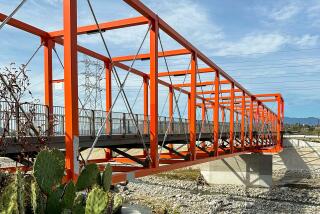Panel Proposes Recreational Uses for River
- Share via
A week after the Los Angeles River provided a raging reminder that it is more than a dry concrete drainage ditch, a city task force on Thursday unveiled a series of proposals to transform the 50-mile waterway into a recreational, cultural and--in places--scenic facility.
The Los Angeles River Task Force, appointed by Mayor Tom Bradley in 1990, announced three demonstration projects to create a more natural setting around the river in the Sepulveda Basin, build a bike path and “greenway” near Griffith Park and stage a “bridge festival” in Elysian Park to celebrate the river’s history.
But the long-term goal, the panel said in a 23-page report, is to reverse the “neglect and disregard” of the river in recent decades.
“As the city becomes more crowded and open spaces become less accessible,” the report noted, “people are turning to the river with the vision of trails and bike paths set in shady greenways forming connections between neighborhoods, parks, and other urban centers.”
But members of the panel, drawn from federal, state and local government agencies and community organizations, acknowledged that moves to increase public access will have to be balanced with measures to maintain the river primarily as a flood control facility and to ensure safety--a problem underscored by the death of a young San Fernando Valley bicyclist washed down the river during a recent storm.
“The water always sets the ground rules,” said Denis Schure, a Sierra Club representative on the task force.
“We need to educate the public to have absolute respect for this . . . to stay out when there’s any rainfall whatsoever.”
Bradley said the city is seeking funding from a variety of sources for the river projects, beginning with an application filed last month for $1 million in state gas tax revenue. Congress has already given a $250,000 grant to the Army Corps of Engineers to study possible improvements in the Sepulveda Basin area.
City planning officials estimated that it will cost $4 million to implement the three demonstration projects:
* A river/recreation link in the Sepulveda Basin. Designed to restore the natural river habitat, it will include a river cleanup, planting of vegetation and creation of a quarter-mile nature trail, eventually to be expanded to two miles. Nature and water safety programs will be offered to school groups and others.
* A Los Angeles River Greenway, featuring lush landscaping along a three-quarter-mile bike path alongside the river near Griffith Park. Planting of a “canopy of trees” would encourage commuter cyclists’ use of the path, which now features views of a power plant and freeway overpasses, the report said.
* An annual bridge festival, to start at the Broadway Bridge near downtown but shifting to other locations each year. Although no firm date has been set, it might be held Aug. 2 to commemorate the day in 1769 when Spanish explorer Gaspar de Portola’s expedition first camped along the river’s banks, the report said. In addition, community and youth groups will be recruited to help create a native plant demonstration garden in Elysian Park featuring, among other things, vegetation used by early Indian inhabitants.
The report calls for drawing up a master plan for the river, which stretches from the foothills of the west San Fernando Valley southward through the downtown area to the Pacific Ocean at Long Beach. The broad goal is “to see if the people can take over the river and turn it into a community asset,” according to Peg Henderson of the National Park Service.
At present, the report noted, much of the river is “hidden beyond the back yards of homes, industries and businesses.”
The Sepulveda Basin demonstration project, the study said, is an effort to “incorporate the Los Angeles River into the adjacent Balboa Park by creating visual and physical linkages.”
This will be accomplished, it said, “by cleaning the river and its banks, developing an accessible interpretive nature trail, improving sight lines by thinning river vegetation, and establishing a river safety and canoeing program.”
The short-term focus will be on a “ponded area” downstream from the Balboa Boulevard bridge, not far from Birmingham High School, where volunteers will help build “an accessible pedestrian trail of decomposed granite or other suitable material” along the north bank of the river, the study said.
The project cost is estimated at $467,000.
At present, the Los Angeles River is fenced along its entire length and is officially closed to the public.
Nevertheless, the task force found, “many people use the river for walking, cycling, horseback riding, canoeing, bird watching, fishing, ‘hanging out,’ bathing, sleeping and washing clothes--all typical activities along any river.”
Even as Bradley released the report Thursday at the site of the proposed “greenway” near Griffith Park, there was a reminder of such unauthorized uses. Two bicyclists rode by inside the fenced area, maneuvering along the sharply banked concrete.
“I noticed this fellow riding his bike along this very slippery bank. . . . We have to keep in mind safety,” the mayor said.
Also because of safety concerns, he indicated, the task force will not consider one recent proposal--the suggestion by state Assemblyman Richard Katz (D-Sylmar) that the riverbed be used for a new freeway.
“No, I think the water spoke for itself,” Bradley said.
More to Read
Sign up for Essential California
The most important California stories and recommendations in your inbox every morning.
You may occasionally receive promotional content from the Los Angeles Times.













